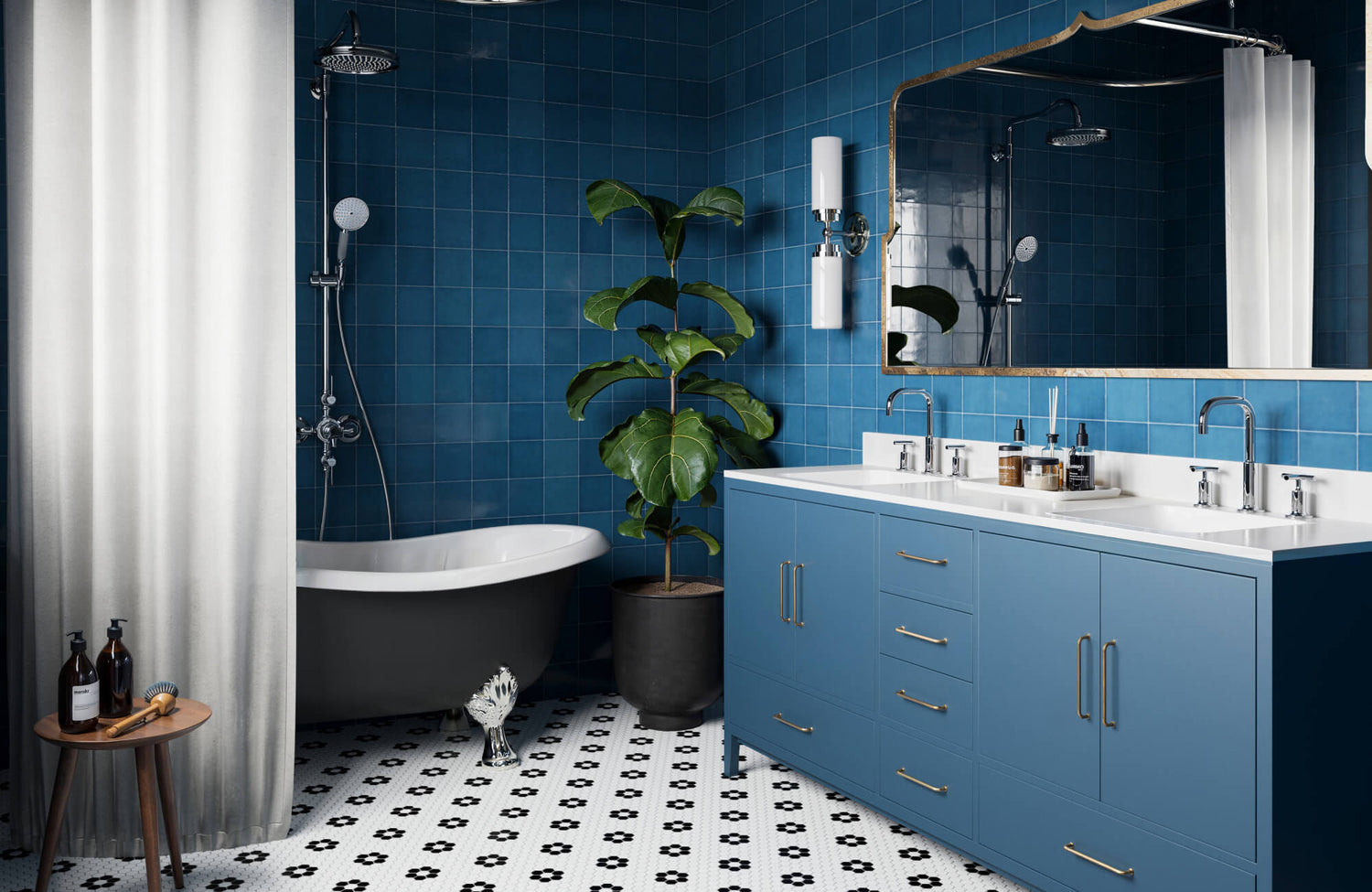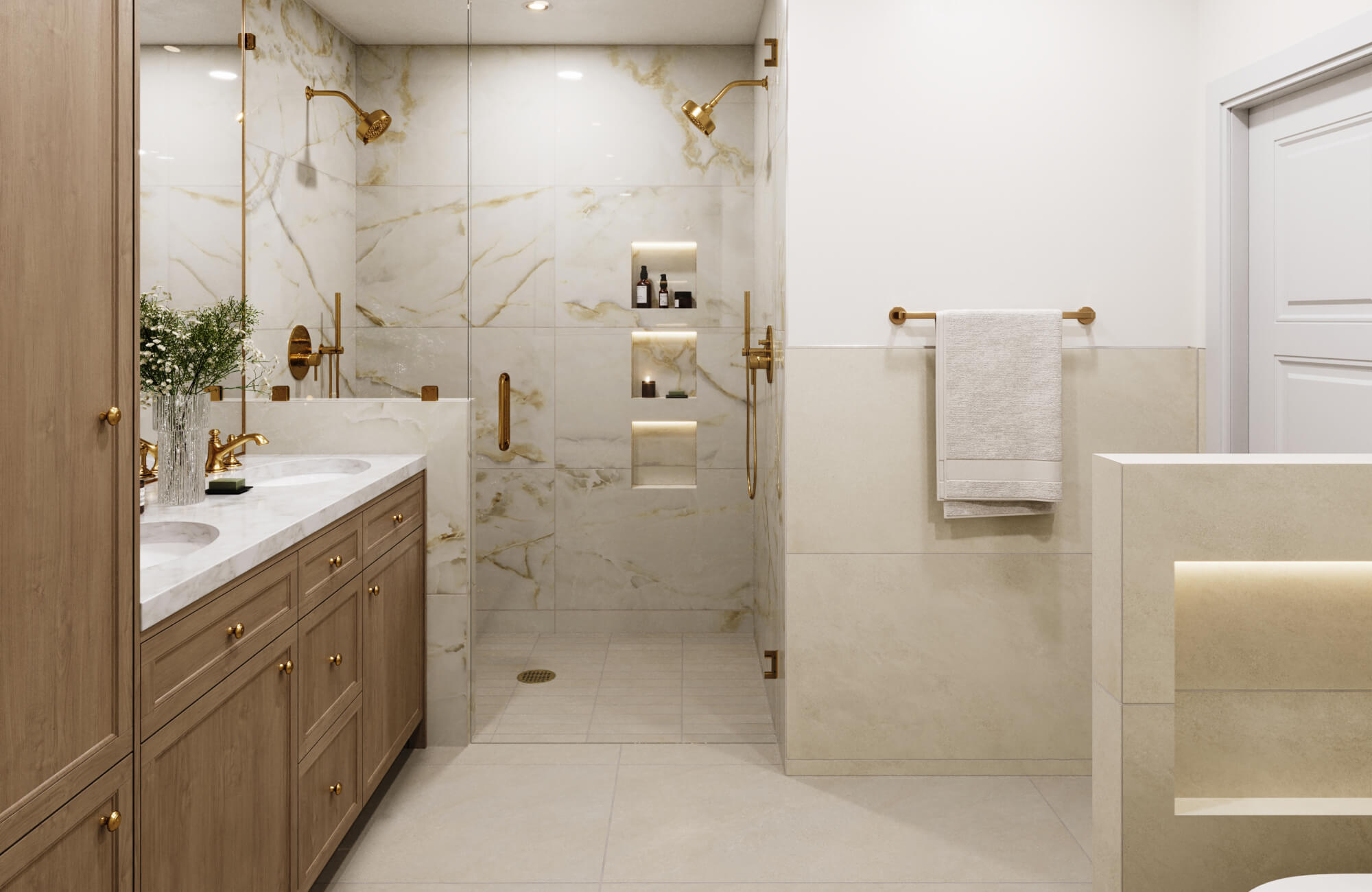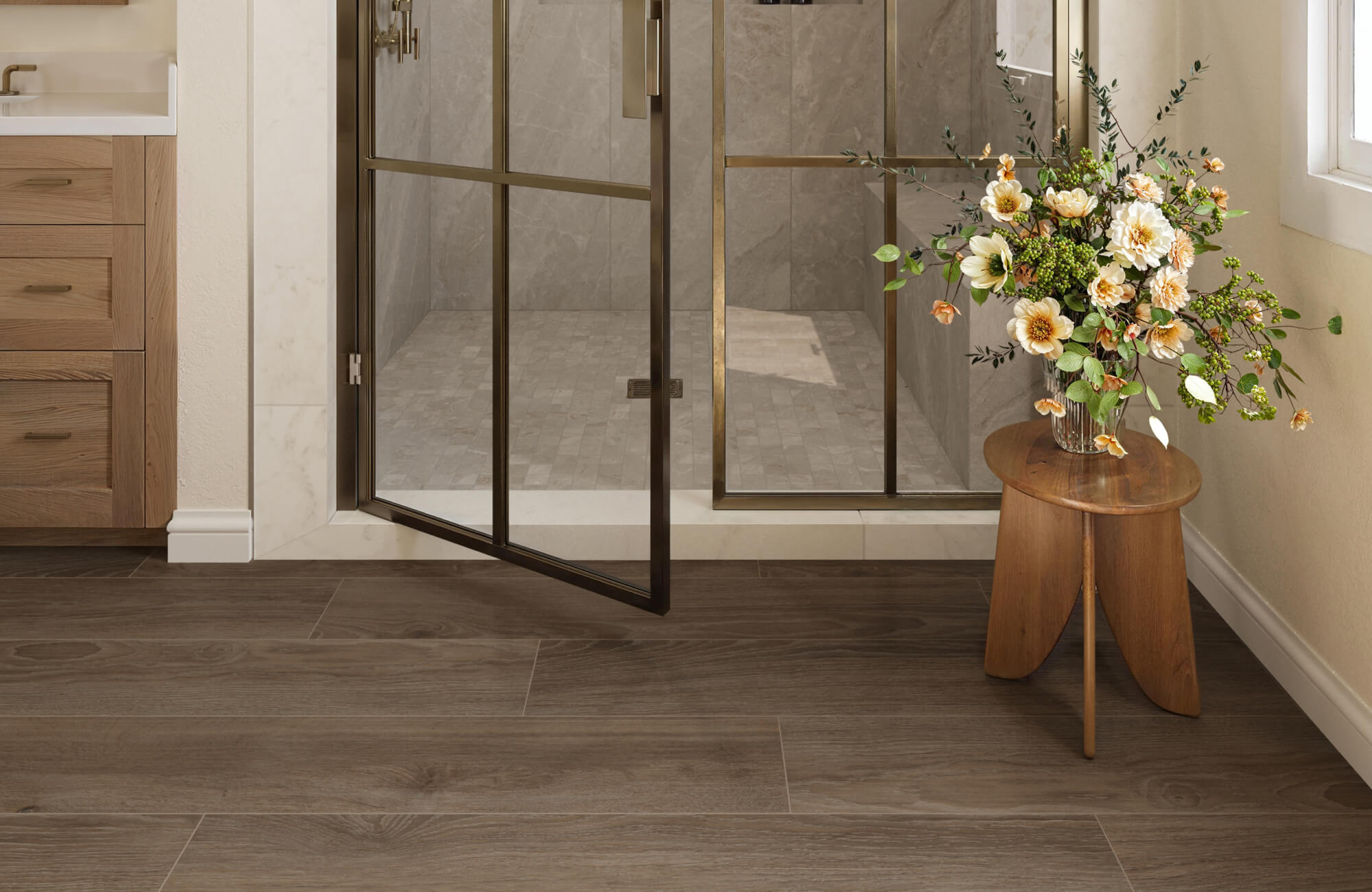Creating a luxurious bathroom begins with selecting premium shower tiles for a luxury bathroom that blend style, durability, and practicality. To ensure you’re choosing the ideal tiles, this guide covers key considerations, from slip resistance and maintenance to the importance of consulting professional tile and design services for safe and optimal installation.

Essential Elements of Shower Tile Selection
Choosing the ideal shower tiles involves achieving a balance between aesthetics, safety, and ease of maintenance. Below are the key factors to consider when selecting tiles for your shower space:
Durable and Water Resistant Materials
In a moisture-prone environment like the shower, durability and water resistance are essential. Non-porous materials, such as ceramic and porcelain, are excellent for repelling water and ensuring the longevity of your shower. Ceramic tiles are well-suited for walls, though they may be more susceptible to chipping if used on floors. Porcelain tiles, on one hand, are known for their exceptional resilience, making them suitable for both walls and floors.
They are also available in a wide range of colors, textures, and finishes, including styles that mimic natural materials like wood or stone. For added comfort and a touch of luxury, consider installing radiant heating beneath these tiles, which can provide warmth and enhance the overall shower experience.
Slip Resistant Finish
Safety is essential when selecting tiles for the shower floor, as wet surfaces can become slippery. Mosaic tiles with matte or textured finishes are ideal for shower floors, as their smaller size requires more grout lines, which provide additional traction and a safer, slip-resistant surface.
Opting for a matte or textured finish further improves safety. While glossy tiles may be visually appealing, they can become slick when wet, increasing the risk of slipping. In contrast, matte finishes offer a subtle roughness that provides natural grip, and textured finishes add even more traction through raised or uneven surfaces, creating a secure footing.
Simplified Cleaning and Maintenance
Choosing easy-to-clean tiles can significantly reduce bathroom maintenance. Both ceramic and porcelain tiles combine practicality and style with their non-porous surfaces, requiring only mild, non-abrasive cleaners and water for upkeep. For instance, Edward Martin’s Adeline 1x3 Matte Porcelain Mosaic Tile in Sand, shown in the photo above, offers a beautiful stone-look finish that brings natural elegance to shower walls and floors without the added maintenance of sealing. Following the manufacturer’s guidelines for tile and grout cleaning ensures your shower maintains its aesthetic appeal and functionality over time
Balancing Budget with Style
Tiles are essential in defining the look and feel of your shower, so selecting styles that align with your preferred design theme—whether modern, minimalist, or coastal—is key. Popular trends include textured surfaces, earthy tones, and stone-inspired designs. Our Augmented Reality (AR) Tool offers a realistic preview of how these choices can appear in your space, helping you make informed design decisions. Adding accent tiles in unique shapes or colors can further personalize the space and create a distinctive look.
Balancing style with budget is equally important. While large-format and mosaic tiles may require professional installation, combining cost-effective options like ceramic with high-end accents such as glass or stone mosaics can create a luxurious look without exceeding your budget. By considering different tile types and installation needs, you can achieve a stunning shower design that brings your vision to life, enhancing both beauty and functionality while staying within budget.

Top Picks for Shower Wall and Floor Tiles
Now that you’ve considered style, budget, and functionality, let’s explore some top shower tile options that bring everything together seamlessly. Here, we highlight some of the best materials and finishes for both floors and walls, each offering a unique blend of practicality and design appeal to suit your vision.
Large Format Tiles
Large format tiles bring a sleek, modern look with minimal grout lines, making them exceptionally easy to maintain while adding an upscale, cohesive appearance. These tiles are perfect for minimalist bathrooms and can make smaller spaces feel larger. For a sophisticated, seamless look throughout your bathroom, Edward Martin’s Leona 12x24 Matte Porcelain Tile in Marfil, as shown in the photo above, is an exceptional choice for both walls and floors. This tile offers outstanding resistance to scratches, stains, and chemicals and is frost and moisture resistant, making it perfect for a polished and durable bathroom environment.
Subway Tiles
Subway tiles are a timeless, versatile choice that works beautifully in both traditional and contemporary settings. Edward Martin’s Graham 3x6 Glossy Ceramic Tile in Clay, also shown in the photo above, adds a refined touch to shower walls with its rustic, handcrafted look and glossy finish, bringing a sense of sophistication to any bathroom. For a fresh, modern twist, these tiles can be arranged in unique layouts such as herringbone patterns, adding subtle visual interest to the design.
Mosaic Tiles
Mosaic tiles are a practical and stylish choice for shower floors, especially those crafted from porcelain with textured finishes, as they provide superior grip due to the many grout lines. Available in a wide array of materials and colors, mosaics can fit various styles and budgets. For instance, Edward Martin’s Leona 3x3 Matte Porcelain Hexagon Mosaic Tile in Marfil is an exceptional option for shower floors, offering a slip-resistant surface that perfectly combines beauty and functionality. As shown in the photo above, this tile pairs beautifully with the Graham wall tiles to create a cohesive, polished look, making it ideal for a well-designed shower space.
Ultimately, each of these tile options combines durability with style, helping you create a bathroom that is both practical and visually appealing. By thoughtfully selecting your wall and floor tiles, you can achieve a cohesive and stunning shower design that reflects your personal style while enhancing your overall bathroom experience.

Tiles to Avoid in Shower Spaces
Not all tiles are suited for high-moisture areas like showers. Avoiding certain materials can enhance the durability, safety, and ease of maintenance in your shower.
Soft, Porous Stones for Wet Areas
Luxurious materials like marble and limestone bring timeless elegance but are prone to staining and require regular sealing, making them less practical for high-moisture environments like showers. For those who love the look of marble but prefer a low-maintenance option, Edward Martin’s Leona 24x24 Matte Porcelain Tile in Nero Marquina, shown in the photo above, offers a stunning and durable alternative suitable for both shower walls and floors. This tile captures the opulent dark color and subtle white veining of Spain’s Nero Marquina marble while providing water-resistance and an easy-to-clean surface.
Glossy Tiles on Shower Floors
Glossy tiles may add a sleek, elegant look but become dangerously slippery when wet, making them unsuitable for shower floors. These tiles work better as decorative accents on walls, where they can enhance brightness and depth without compromising safety. For a sophisticated touch, consider the Jaden 2.5x16 Glossy Ceramic Tile in Hunter, which brings a vibrant, glossy finish to accent walls and creates a spacious, open feel in the shower area.
Large Tiles on Shower Floors
Large format tiles can present challenges on shower floors due to their dimensions. With fewer grout lines, these tiles offer reduced traction, increasing the potential for slips. Additionally, their tile size can make it difficult to achieve the necessary slope toward the drain, which may result in drainage issues over time.
Creating a Cohesive Bathroom Style
Selecting tiles that blend function with design requires a thoughtful approach to create a harmonious look. By carefully considering style, patterns, colors, and installation techniques, you can achieve a bathroom aesthetic that reflects your vision.
Defining the Bathroom’s Overall Style
Aligning tile choices with your bathroom’s theme helps achieve a unified look. Whether you prefer a modern, minimalist, or coastal design, defining the overall style simplifies the tile selection process and guides other design choices.
Modern and Sleek
For a contemporary look, choose tiles with clean lines, large formats, and neutral tones. Options like polished porcelain and concrete-look tiles bring sophistication with a minimalist edge.
Classic and Timeless
Traditional bathrooms benefit from subway tiles, marble-inspired finishes, or muted colors. These classic choices add elegance, complementing a timeless decor.
Natural and Rustic
For a warm, earthy appeal, wood-look porcelain or stone-inspired tiles work beautifully. Combining these with textured accents creates an inviting, natural atmosphere.
Coastal and Relaxed
To evoke a coastal feel, opt for soft hues like blues and whites. Mosaic accents or sea-inspired textures also contribute to a serene, relaxed ambiance.
Complementary Patterns and Textures
Blending patterns and textures thoughtfully can further elevate a bathroom’s design, adding depth, character, and visual interest. For instance, using large format tiles on both bathroom walls and floors paired with smaller mosaic accents on shower floors creates a harmonious contrast that draws attention without overwhelming the space.
Geometric patterns also pair beautifully with organic or textured elements, achieving a balance between structured lines and natural forms. As an example, earthy tones with varied textures, like stone-inspired porcelain in a matte mosaic format, can evoke a spa-like tranquility. Moreover, you can choose matte finishes on floor tiles complemented by satin wall tiles to introduce a contrast that remains unified and sophisticated.
Ultimately, each design choice should enhance the others, fostering a seamless aesthetic that doesn’t compromise functionality. Well-chosen patterns and textures enrich the bathroom’s atmosphere, resulting in a visually dynamic yet harmonious retreat.
Choosing Balanced Colors and Tones
Color and tone selections also play a crucial role in creating a balanced and inviting bathroom design. By thoughtfully choosing colors that complement each other, you can craft a space that feels both cohesive and aesthetically pleasing.
Classic Neutrals with Warm Accents
Neutral tones like whites, soft beiges, and light grays paired with warm taupes or muted browns create a timeless and versatile look. These tones provide a sophisticated backdrop, while adding subtle warmth through earthy colors prevents the space from feeling too stark.
Soft Blues with Whites and Grays
Light blues or seafoam greens paired with crisp whites and cool grays evoke a coastal, calming effect. This palette is ideal for bathrooms aiming for a refreshing, spa-like ambiance. The softer blue shades can serve as gentle focal points, balancing beautifully with the clean look of whites and grays.
Earthy Tones with Natural Textures
Warm earthy tones like terracotta, soft browns, and olive greens combined with beige or off-white add a natural, rustic charm. These tones bring subtle energy and a grounded feel to the bathroom, while beige and off-white balance the warmth, ensuring harmony. This palette works exceptionally well with stone-look or wood-look tiles, enhancing the organic appeal.
Bold Accents with Soft Neutrals
Soft grays or beiges as the primary color, highlighted by bold, rich hues like navy, emerald, or charcoal, create a modern and upscale feel. Bold colors used as accents on feature walls add depth and character without overwhelming the space, offering a striking contrast that keeps the bathroom balanced and visually dynamic.
Monochromatic with Layered Shades
Using different shades within the same color family, such as light gray, charcoal, and slate, brings a sophisticated, seamless look to the bathroom. A monochromatic scheme adds depth and texture without the need for contrasting colors, making it ideal for minimalist or modern designs that emphasize harmony and simplicity.
Choosing the Ideal Tile Height for Shower Walls
Selecting the right tile height for shower walls balances functionality, aesthetics, and budget. Whether tiling partially or up to the ceiling, each option offers distinct advantages to suit different bathroom styles and needs.
The 8-Foot Compromise
Tiling your shower walls to 8 feet presents a practical and budget-friendly approach, offering sufficient water protection for most standard shower setups while reducing the materials and labor required compared to full-height tiling. This height is also well-suited to traditional design aesthetics, blending seamlessly into a variety of home styles.
However, leaving the wall above the tile line exposed may lead to potential issues, particularly in high-moisture environments. The upper, painted wall can become vulnerable to water damage over time, especially in steam showers, where humidity levels are higher. Moreover, the exposed areas may demand more frequent cleaning and maintenance to prevent mold and mildew growth, as painted surfaces can be harder to maintain in damp conditions.
Full-Height Tiling
On the other hand, full-height tiling to the ceiling brings a sense of luxury and enhanced functionality. Extending the tiles provides complete protection against water damage, making it an ideal choice for moisture-heavy spaces and steam showers. This approach also elevates the bathroom’s aesthetics, creating a sleek, seamless look that visually expands the space and complements modern design sensibilities. Despite these benefits, full-height tiling does have drawbacks. The additional tile and labor required make it a more expensive option, and achieving a flawless ceiling-height finish often necessitates professional installation to ensure precision.
Ensuring Waterproofing and Quality Installation
Proper installation and waterproofing are essential to creating a shower that withstands daily use and moisture over time. Quality waterproofing prevents water from seeping behind the tiles, which can lead to costly issues such as mold, mildew, and structural damage. A professional installer may apply specialized waterproof membranes and sealants to create a robust barrier, safeguarding the subfloor and walls from moisture penetration.
Additionally, expert tile installation ensures even spacing, proper grout application, and secure adhesion, which are critical for both the aesthetic appeal and durability of your shower space. Investing in quality installation also improves the bathroom’s longevity by minimizing potential maintenance and repair needs, since professionally installed tiles are less likely to shift, crack, or develop leaks.
In the long term, this level of precision and care protects your investment, ensuring that your bathroom remains both beautiful and resilient for years to come. For the best results, we recommend consulting with a professional to ensure that your shower installation meets high standards of waterproofing and craftsmanship.
Creating a Lasting Impression with Cohesive Shower Tile Selections
By following the strategies laid out in this guide, you can choose shower tiles that seamlessly blend beauty, functionality, and low maintenance. To help you make the best selection, we offer 4" x 4" tile samples so you can experience each tile’s texture and color in person. Our design services are also available to create tailored solutions that align with your unique aesthetic and practical needs. With the right tile choices, your shower can become a standout feature that enhances the look and feel of your entire bathroom, offering both luxury and long-lasting performance.
Frequently Asked Questions (FAQ)
Have more questions? Here are answers to other frequently asked questions to help you make informed tile choices for your bathroom.
1. How should we select grout colors to enhance our shower tile choice?
Grout color significantly influences your shower tile’s appearance. Contrasting grout highlights tile patterns, while matching grout offers a seamless look. Darker grout can also hide stains effectively in busy areas.
2. What steps can prevent mold growth on shower tiles?
Proper ventilation, regular cleaning with a mild, non-abrasive cleaner, and sealing grout lines help reduce mold buildup in showers.
3. How often should shower grout be resealed?
In high-moisture settings, grout should be resealed every six months to a year. This helps prevent water damage and keeps the shower area fresh. Still, it’s best to consult your grout manufacturer for specific recommendations, as different grout types may have unique requirements for optimal maintenance.
4. Is professional installation necessary for shower tiles?
While some tiles are DIY-friendly, professional installation ensures proper waterproofing, alignment, and safety, especially for intricate designs.
5. Can the same tiles be used for both bathroom and shower floors?
Yes, but ensure that the shower floor tiles are slip resistant. Many homeowners choose to vary texture or pattern between the shower and bathroom floor to create subtle contrast.









